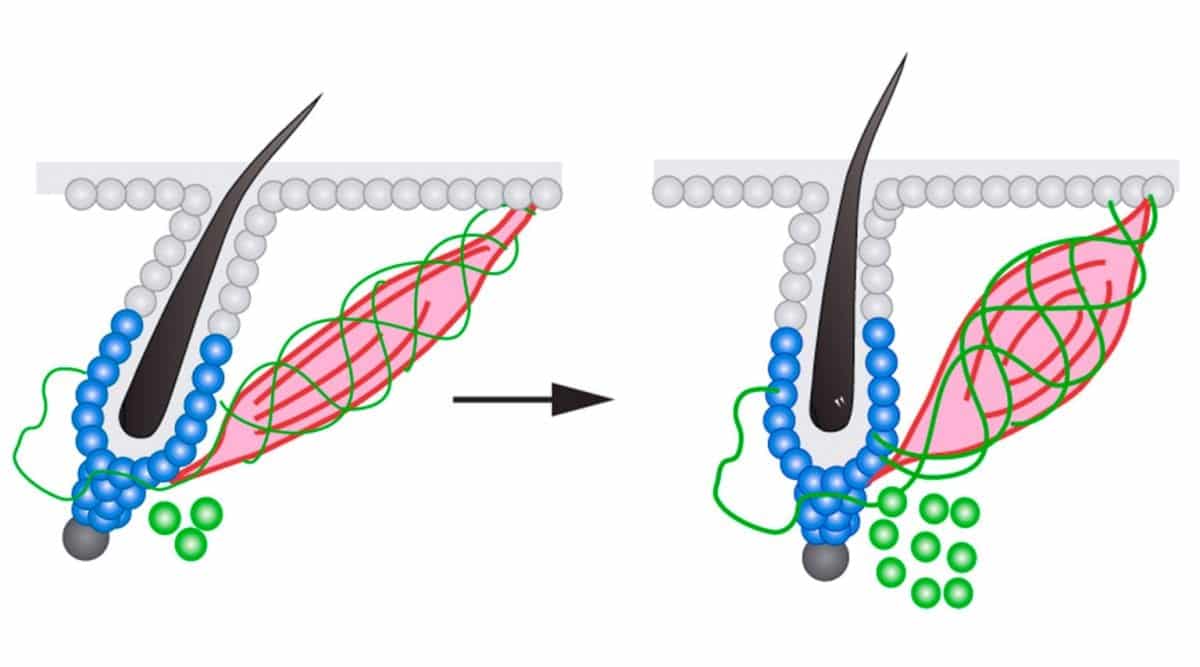Why do you get goosebumps?
Have you ever before questioned why we get goosebumps? In animals with thick fur goosebumps might protect them from the cold, however, we humans don’t seem to take advantage of the reaction much – so why has it been maintained throughout the evolution process?
In recent research, scientists from Harvard University have discovered the reason behind this: the cell types that trigger goosebumps are also essential for regulating the stem cells that regrow the hair and hair follicle. The muscle mass that contracts underneath the skin to create goosebumps is required to bridge the connection between hair follicle stem cells and sympathetic nerves. This nerve responds to cold by contracting the muscular tissue and causing goosebumps in the short period, as well as in over the long term by driving hair follicle stem cell activation and new hair growth.
The outcomes of the study are published in the journal Cell. The research in mice gives a better insight into exactly how various cell types interact to link stem cell activity with modifications in the external atmosphere.

Ya-Chieh Hsu, the Alvin, and Esta Star Associate Professor of Stem Cell and Regenerative Biology said that they constantly had an interest in recognizing how exterior stimuli regulate the behaviors of stem cells.
Ya-Chieh Hsu said that the skin is an interesting system: is located at the interface between our body and the external environment and it has multiple stem cells surrounded by diverse cell types. As a result, to a varied range of stimulations, its stem cells could potentially respond – from outside, the niche, or the entire body. An interesting dual-component niche was discovered in this study that not only regulates the stem cells under steady-state, however, based on the external temperature changes, it additionally modulates stem cell behaviors.
System for regulating hair growth
Three types of tissue: nerve, mesenchyme, and epithelium tissue forms most of the organs. These 3 lineages are arranged in a unique arrangement in the skin. Part of our nervous system that controls our responses to external stimulations and body homeostasis – the sympathetic nerve connects with a small smooth muscle in the mesenchyme tissue. In turn, this smooth muscle connects to hair follicle stem cells, a type of epithelial stem cell crucial for healing wounds and regrowing the hair follicle.
Considering that the sympathetic nerve and the muscle are the cellular basis behind goosebumps, the link between them has been popular. Sympathetic neurons are triggered by the cold to send a nerve signal, and the muscular tissue responds by contracting and making the hair stand, causing goosebumps. But, the scientists discovered that the sympathetic nerve is not only associated with the muscle but also formed a direct link to the hair follicle stem cell when analyzing the skin under extremely high resolution using electron microscopy. Indeed the nerve fibers are wrapped like a ribbon around the hair follicle stem cells.
Hsu said that at an ultrastructure level they could really see the interaction of the nerve and the stem cell. Like other neurons or muscular tissue with synapses, neurons often tend to control excitable cells. However, we were shocked to discover that they create comparable synapse-like frameworks with an epithelial stem cell, which is not a very typical target for nerve cells.
The nerve indeed targeted the stem cells, which was later confirmed by the scientists. To maintain body homeostasis, the sympathetic nervous system is usually activated at a constant low level, and the researchers found that the stem cells are maintained in a poised state ready for regrowth by this reduced level of nerve activity. The nerve was activated at a much higher level under prolonged cold, and also more neurotransmitters were released, creating the stem cells to activate rapidly, regrow the hair follicle, as well as grow new hair.
What maintained the nerve connections to the hair stem cells was additionally investigated by the scientists. The sympathetic nerve retracted, and also the nerve connection to the hair follicle stem cells was lost, when they eliminated the muscle attached to the hair follicle, showing that the muscle was required structural support to bridge the sympathetic nerve to the hair follicle.
Exactly how the system develops
The researchers investigated how the system initially develops – just how the muscle and nerve reach the hair roots n the first place, along with researching the hair follicle in its fully formed state.
Yulia Shwartz, a postdoctoral fellow in the Hsu lab and Chih-Lung Chen, a postdoctoral other in the Lin lab said that they discovered that the signal comes from the developing hair follicle itself. A protein that regulates the development of the smooth muscle is produced by the hair follicle, which after that attracts the sympathetic nerve. With the nerve and muscle together controlling the hair follicle stem cells to regrow the new hair follicle, the interaction turns around in the adult. It’s very own niche is created by the developing hair follicle.
Responding to the environment
The scientists determined a two-component system that manages hair follicle stem cells with these experiments. The muscle is the structural part that enables the nerve fibers to directly connect with hair roots stem cells, while the nerve is the signaling element that activates the stem cells via neurotransmitters.
Shwartz said that hair follicle stem cells are wonderful models to study tissue regeneration and can be regulated in numerous methods. This specific reaction is valuable for coupling tissue regeneration with modifications in the external environment. The reaction is a 2-layer response: providing some relief quickly in a short period can be provided by goosebumps. This becomes a good mechanism for the stem cells when the cold lasts, to understand it’s time to regenerate new hair follicles.
The scientists will certainly further explore how the outside environment might affect the stem cells in the skin, both in repair circumstances and homeostasis.
Hsu said that we live in an environment that frequently changes. It offers us an opportunity to study what mechanisms stem cells in our body use to incorporate tissue production with transforming needs, which is vital for organisms to grow in this dynamic globe, considering that the skin is always in contact with the external environment.
This research was supported by the New York Stem Cell Foundation, National Taiwan University Hospital, Pew Charitable Trusts, National Institutes of Health, Smith Family Foundation Odyssey Award, Harvard Stem Cell Institute, American Cancer Society, Taiwan Ministry of Science and Technology, Harvard Medical School Dean’s Innovation Grant, and Harvard NeuroDiscovery Center.
Author: Sruthi S
































